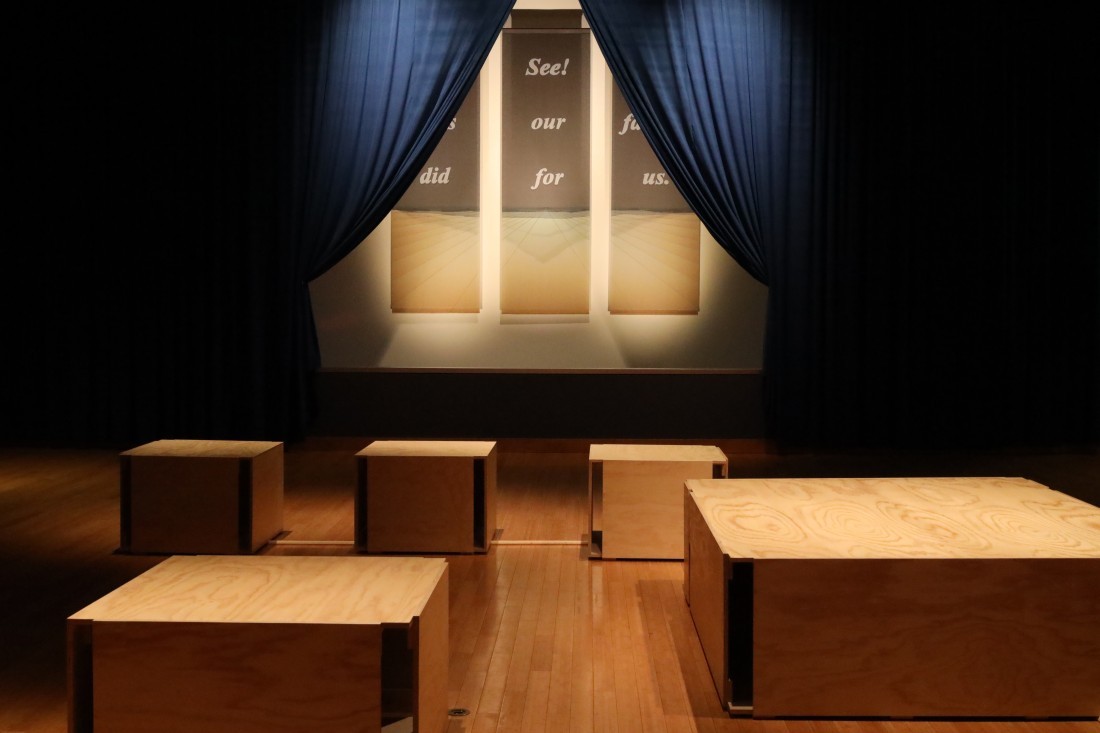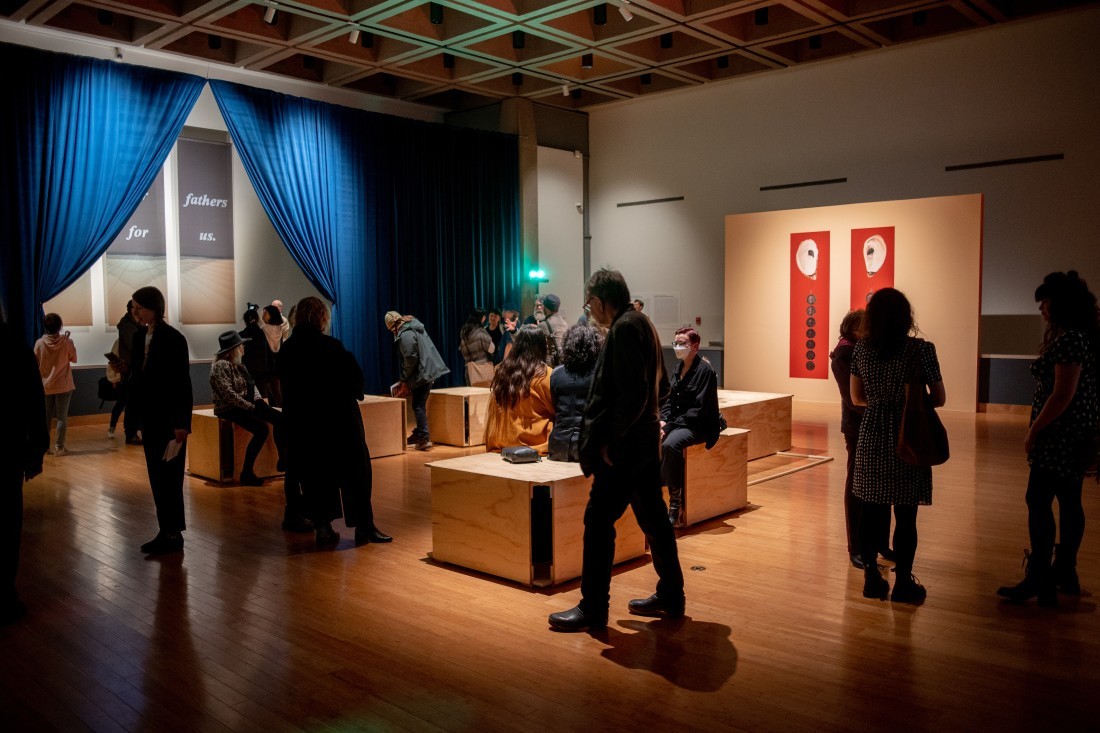“Cabinet Music (Cantata for Erosion)”
Buildings are complicated systems that most of us take for granted. Like so much of the designed and built environment we inhabit, we tend to notice only what’s gone wrong: an escalator that isn’t working, doors with broken handles, HVAC systems that produce heat when we want it cold and vice versa. But buildings, obviously, are more than the sum of their working (or non-working) parts. They are the sum of countless decisions, all of which impact their inhabitants. Buildings are also the products of their times, and like anything we tool-wielding animals make, they display the assumptions, biases and predilections of the culture that built them.
Art galleries are particularly interesting constructs because they can be so contentious. Artists and curators expect certain things from them, while funders, operators, visitors and, of course, architects expect other, often contradictory things. Artists and curators tend to want the architecture to be invisible, to serve as a neutral enclosure for artworks. Operators want revenue-generating spaces such as shops and restaurants, and events spaces such as theatres, atria and large, empty rooms. What wedding parties want from a gallery is different from, and usually at odds with, what artists want. Of course, the art is the ostensible reason for the building, but anyone who has spent any time in museums knows that such buildings are about much more than their display function.

Installation view, “Cabinet Music (Cantata for Erosion),” 2023, Confederation Centre of the Arts, Charlottetown. Courtesy Confederation Centre of the Arts, Charlottetown. Photo: Gerald Beaulieu. Front to back: Lou Sheppard & William Robinson, Six Pavilions (Risers/Rafts), 2023, plywood cabinets with audio; Lou Sheppard & William Robinson, Tideline 2264 (Tricentennial), 2023, curtains, blue velvet fabric & performance score; Lou Sheppard, The Lamp of Memory, 2023, inkjet print on linen fabric.
Halifax artists William Robinson and Lou Sheppard think a lot about how institutions (and the buildings that house them) function pragmatically, ideologically and idealistically. For these artists, galleries are not vessels to contain their work but often the actual subjects and objects of their practice. They work with and on buildings, analyzing and deconstructing these complex constructions— figuratively, of course, as no buildings have so far crumbled under their scrutiny. Instead, they question buildings, peeling away the layers of habit and convention that blind us to what we encounter every day. In a way, under their ministrations, buildings speak.
The Confederation Centre in Charlottetown is both building and monument, and like all buildings it is a collaboration of sorts. Indeed, this brutalist classic is more collaborative than most, with three artists getting credit for its design: architect Dimitri Dimakopoulos, theatre designer George Izenour and sculptor Gérard Tremblay. Conceived as a monument to Confederation and built between 1963 and 1965, the Confederation Centre of the Arts originally housed an art gallery and museum, a theatre and a library. Seemingly all slabs, in aggressive horizontals and often dizzying vertical rises and descents, the complex seems to revolve around a series of stairs, balconies, mezzanines and clerestories. If it speaks, it is in a slow, laborious chant—the breathlessness, perhaps, of the viewer navigating these spaces. There is little accessible about this building, either intellectually or physically. It is emphatically and unapologetically cerebral and coldly beautiful. Nonetheless, it has faded with familiarity and been eroded by use and the elements. And the complex as a whole benefits from the careful, reinvigorating analysis of Sheppard and Robinson.
“Cabinet Music (Cantata for Erosion)” was exhibited in the clerestory gallery on the Confederation Centre Art Gallery’s second floor. This large, square room is atypical for a gallery space in that it has only one easily accessible wall (it is a room designed for sculpture, back when sculpture was predictably floor- or plinth-bound). One other wall is blocked by a staircase, while the remaining two, which face each other, are separated from the gallery space by a gap of some yards, setting them apart from the main gallery space, and making any installation a matter of scaffolding and scissor lifts. Robinson and Sheppard heightened the drama of these soaring walls, framing them in dark velvet theatre curtains, spotlighting the single piece of work (one by each artist) installed on each. The distance to the wall, the physical gap, made artistic sense in their installation, revealing the basic function of a gallery wall—as a stage.

Installation view, “Cabinet Music (Cantata for Erosion),” 2023, Confederation Centre of the Arts, Charlottetown. Courtesy Confederation Centre of the Arts, Charlottetown. Photo: Oakar Myint.
The centre of the gallery was occupied by six geometric forms, near cubes made out of birch plywood. With these rudimentary depictions of the pavilions of the Confederation Centre complex, the gallery floor then became the pedestal upon which the pavilions’ more prosaic functions are concealed in real life. Contrary to the distancing effected by the walls and curtains, these artworks were inviting, even serving as seating in the otherwise near-empty space. A temporary wall at the end of the gallery supported a pair of large photographs, and the opposite wall contained two other works, a partially unspooled cassette tape and a small photograph. The viewer’s attention was thus constantly pulled across the room, from close-up to wide focus, as the viewer strove to make sense of the work and its dynamics.
Visually spare, the room is nonetheless quite full, as the wooden sculptures, Six Pavilions (Risers/ Rafts), 2023, resonated with sound, two looped aural compositions that swell and fall with a near-tidal rhythm, affected by the feedback of viewers in the gallery space. Playing in succession, the two sound works— one by Joel Waddell and William Robinson and the other by Lou Sheppard—continue the analysis of the building, context and history of the Confederation Centre that played out in the physical artworks on view. A combination of images, texts, objects and sounds, “Cabinet Music (Cantata for Erosion)” is a total artwork (gesamtkuntswerk), calling on all the senses, much as buildings themselves do.
Lobby Music 33 (RSL 2.5m Scenario 2215-), 2023, was composed by Waddell from a graphic score by Robinson, an aural transcription of a physical space into a sound sculpture that fills the near-empty room. Where Robinson focuses on the form of the building in his piece, Sheppard turns to the building’s monumental function. The Maple Leaf Forever, 2023, features a Sheppard arrangement of Alexander Muir’s 1867 anthem performed by the Saint David’s Singers, the contemporary manifestation of a choir that performed at the official opening of the Centre. Sheppard’s arrangement breaks down the song, evoking the process of erosion cited in the exhibition’s title.
Through sound works, sculpture, photographs and installation Sheppard and Robinson explore how public buildings—and through their study of this particular building—present, contain and lose meaning. Like a recording on a partially erased tape, the artists write over the former content, while leaving traces of the official narrative, a distorted echo that reverberates in this careful deconstruction of Canada’s monument to Confederation. ❚
“Cabinet Music (Cantata for Erosion) ” was exhibited at Confederation Centre Art Gallery, Charlottetown, from March 18, 2023, to May 21, 2023.
Ray Cronin is a Nova Scotia-based writer, editor and curator. He is the author of 14 books on Canadian art and the editor-in-chief of Billie: Visual Culture Atlantic.

